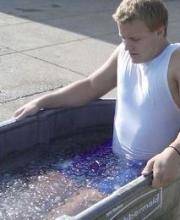
Exertional heat stroke (EHS) is one of the three leading causes of death in sport (and the leading cause in the summer). But death from exertional heat stroke is 100 percent preventable when proper recognition and treatment protocols are implemented. Putting the right programs into place is essential to prevent and treat exertional heat illnesses and ensure appropriate care is in place.
Prevention
• A heat acclimatization policy should be implemented to allow athletes to be acclimatized to the heat gradually over a period of 7 to 14 days. This is optimal for full heat acclimatization.
• Plan rest breaks and modify the work-to-rest ratio to match environmental conditions and the intensity of the activity.
• When environmental conditions warrant, ensure that a cold water immersion tub and ice towels are available to quickly manage an athlete with a suspected heat illness.
Recognition
• The two main signs of exertional heat stroke (EHS) are profound central nervous system (CNS) dysfunction and a core body temperature above 105°F.
• Rectal temperature is the only method of obtaining an immediate and accurate measurement of core body temperature in an exercising individual.
Treatment
• Cooling first and transport second should be the rule, first and foremost. The goal for any exertional heat stroke victim is to lower core body temperature to less than 102.5°F within 30 minutes of collapse.
• Cold water immersion is the most effective way to treat a patient with exertional heat stroke. The water should be 35-59°F and continuously stirred to maximize cooling. EHS has had a 100% survival rate when immediate cooling via cold water immersion or aggressive whole body cold water dousing is started within 10 minutes of collapse.
• Among less effective treatment options are:
• fanning the body;
• wet-towel application to the thorax (the part of the body between the neck and the diaphragm) and abdomen;
• ice-pack application to neck, groin and armpits; and
• showering the body with water combined with fanning.
• An athlete recovering from exertional heat stroke should be closely monitored by a physician or athletic trainer and returned to gradual activity.
Plan ahead
• Include cold-water immersion, if possible, when setting up a plan for treating exertional heat stroke.
• Ice in coolers adjacent to tubs filled with water should be available for rapid cooling of athletes suffering from EHS.
• In areas where cold-water tubs are impractical, plan to have a cooler available containing ice, water and towels.
• The cold, wet towels should be changed every two to three minutes as a means of reducing body temperature.
• Alternatively, a large water supply should be available for the continual dousing of a patient (either from a hose or multiple water containers).



